Analyzing Business Environments: Toyota, Red Cross, and Oxfam Report
VerifiedAdded on 2020/06/05
|22
|6705
|67
Report
AI Summary
This report delves into the business environments of Toyota, Red Cross, and Oxfam, examining their organizational structures, purposes, and functions. It differentiates between profit, non-profit, and non-governmental organizations, exploring the impact of macro environments on business operations. The report analyzes market share, profit share, and sustainability across different organizational sizes, including micro, small, medium, and large scales. It further investigates the relationships between various organizational functions and their roles in achieving business objectives. The report provides a comprehensive overview of the business landscape, highlighting internal and external factors that influence the success of these organizations.
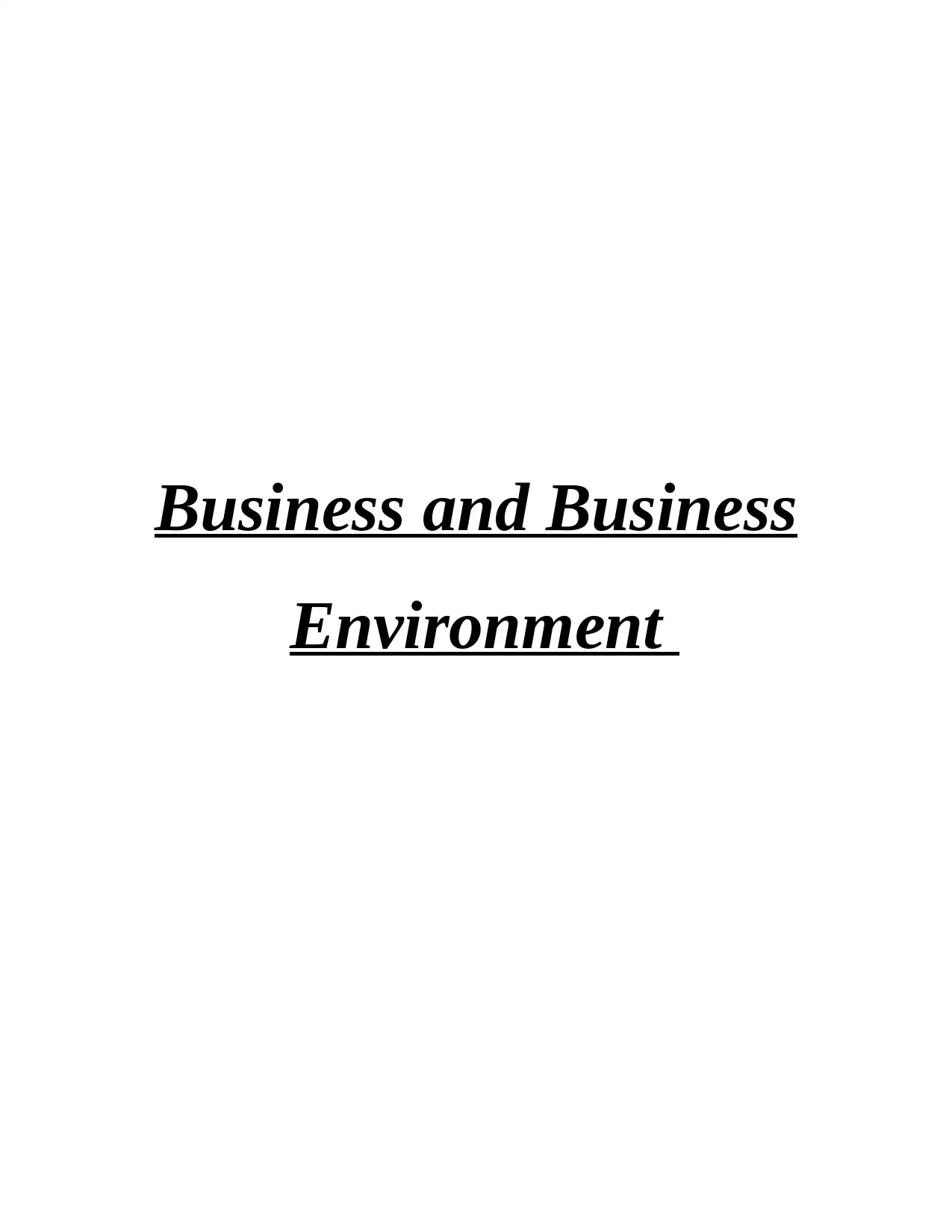
Business and Business
Environment
Environment
Paraphrase This Document
Need a fresh take? Get an instant paraphrase of this document with our AI Paraphraser
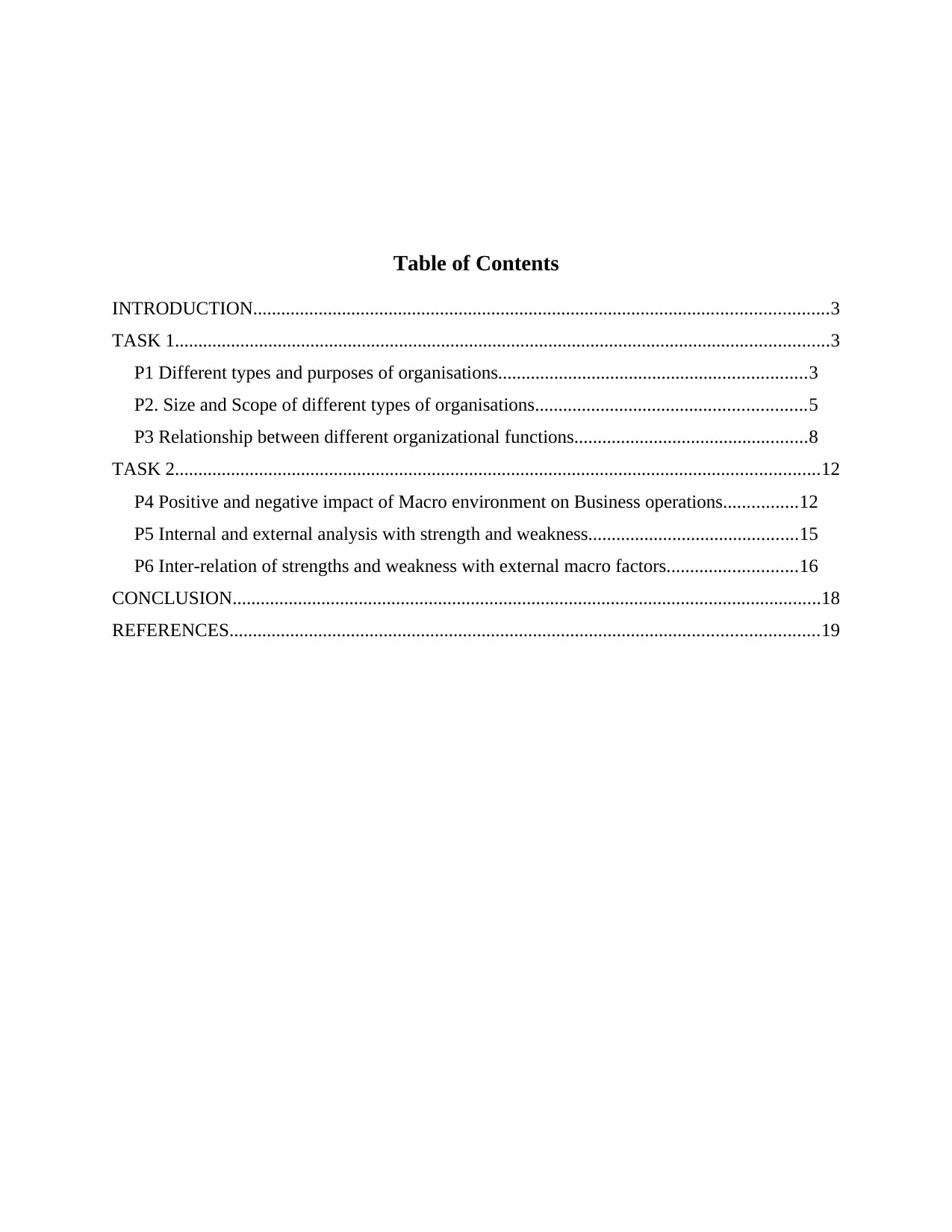
Table of Contents
INTRODUCTION...........................................................................................................................3
TASK 1............................................................................................................................................3
P1 Different types and purposes of organisations..................................................................3
P2. Size and Scope of different types of organisations..........................................................5
P3 Relationship between different organizational functions..................................................8
TASK 2..........................................................................................................................................12
P4 Positive and negative impact of Macro environment on Business operations................12
P5 Internal and external analysis with strength and weakness.............................................15
P6 Inter-relation of strengths and weakness with external macro factors............................16
CONCLUSION..............................................................................................................................18
REFERENCES..............................................................................................................................19
INTRODUCTION...........................................................................................................................3
TASK 1............................................................................................................................................3
P1 Different types and purposes of organisations..................................................................3
P2. Size and Scope of different types of organisations..........................................................5
P3 Relationship between different organizational functions..................................................8
TASK 2..........................................................................................................................................12
P4 Positive and negative impact of Macro environment on Business operations................12
P5 Internal and external analysis with strength and weakness.............................................15
P6 Inter-relation of strengths and weakness with external macro factors............................16
CONCLUSION..............................................................................................................................18
REFERENCES..............................................................................................................................19
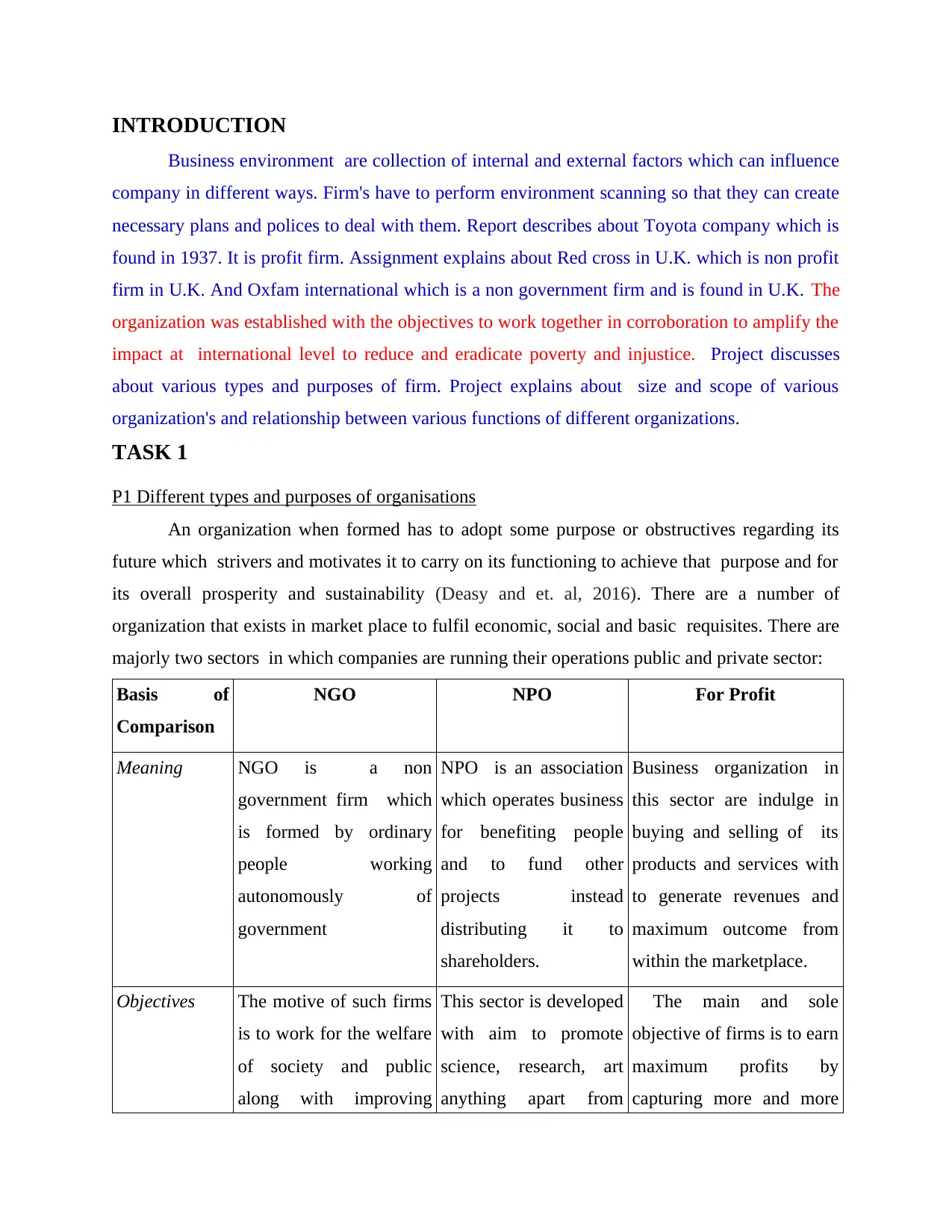
INTRODUCTION
Business environment are collection of internal and external factors which can influence
company in different ways. Firm's have to perform environment scanning so that they can create
necessary plans and polices to deal with them. Report describes about Toyota company which is
found in 1937. It is profit firm. Assignment explains about Red cross in U.K. which is non profit
firm in U.K. And Oxfam international which is a non government firm and is found in U.K. The
organization was established with the objectives to work together in corroboration to amplify the
impact at international level to reduce and eradicate poverty and injustice. Project discusses
about various types and purposes of firm. Project explains about size and scope of various
organization's and relationship between various functions of different organizations.
TASK 1
P1 Different types and purposes of organisations
An organization when formed has to adopt some purpose or obstructives regarding its
future which strivers and motivates it to carry on its functioning to achieve that purpose and for
its overall prosperity and sustainability (Deasy and et. al, 2016). There are a number of
organization that exists in market place to fulfil economic, social and basic requisites. There are
majorly two sectors in which companies are running their operations public and private sector:
Basis of
Comparison
NGO NPO For Profit
Meaning NGO is a non
government firm which
is formed by ordinary
people working
autonomously of
government
NPO is an association
which operates business
for benefiting people
and to fund other
projects instead
distributing it to
shareholders.
Business organization in
this sector are indulge in
buying and selling of its
products and services with
to generate revenues and
maximum outcome from
within the marketplace.
Objectives The motive of such firms
is to work for the welfare
of society and public
along with improving
This sector is developed
with aim to promote
science, research, art
anything apart from
The main and sole
objective of firms is to earn
maximum profits by
capturing more and more
Business environment are collection of internal and external factors which can influence
company in different ways. Firm's have to perform environment scanning so that they can create
necessary plans and polices to deal with them. Report describes about Toyota company which is
found in 1937. It is profit firm. Assignment explains about Red cross in U.K. which is non profit
firm in U.K. And Oxfam international which is a non government firm and is found in U.K. The
organization was established with the objectives to work together in corroboration to amplify the
impact at international level to reduce and eradicate poverty and injustice. Project discusses
about various types and purposes of firm. Project explains about size and scope of various
organization's and relationship between various functions of different organizations.
TASK 1
P1 Different types and purposes of organisations
An organization when formed has to adopt some purpose or obstructives regarding its
future which strivers and motivates it to carry on its functioning to achieve that purpose and for
its overall prosperity and sustainability (Deasy and et. al, 2016). There are a number of
organization that exists in market place to fulfil economic, social and basic requisites. There are
majorly two sectors in which companies are running their operations public and private sector:
Basis of
Comparison
NGO NPO For Profit
Meaning NGO is a non
government firm which
is formed by ordinary
people working
autonomously of
government
NPO is an association
which operates business
for benefiting people
and to fund other
projects instead
distributing it to
shareholders.
Business organization in
this sector are indulge in
buying and selling of its
products and services with
to generate revenues and
maximum outcome from
within the marketplace.
Objectives The motive of such firms
is to work for the welfare
of society and public
along with improving
This sector is developed
with aim to promote
science, research, art
anything apart from
The main and sole
objective of firms is to earn
maximum profits by
capturing more and more
⊘ This is a preview!⊘
Do you want full access?
Subscribe today to unlock all pages.

Trusted by 1+ million students worldwide
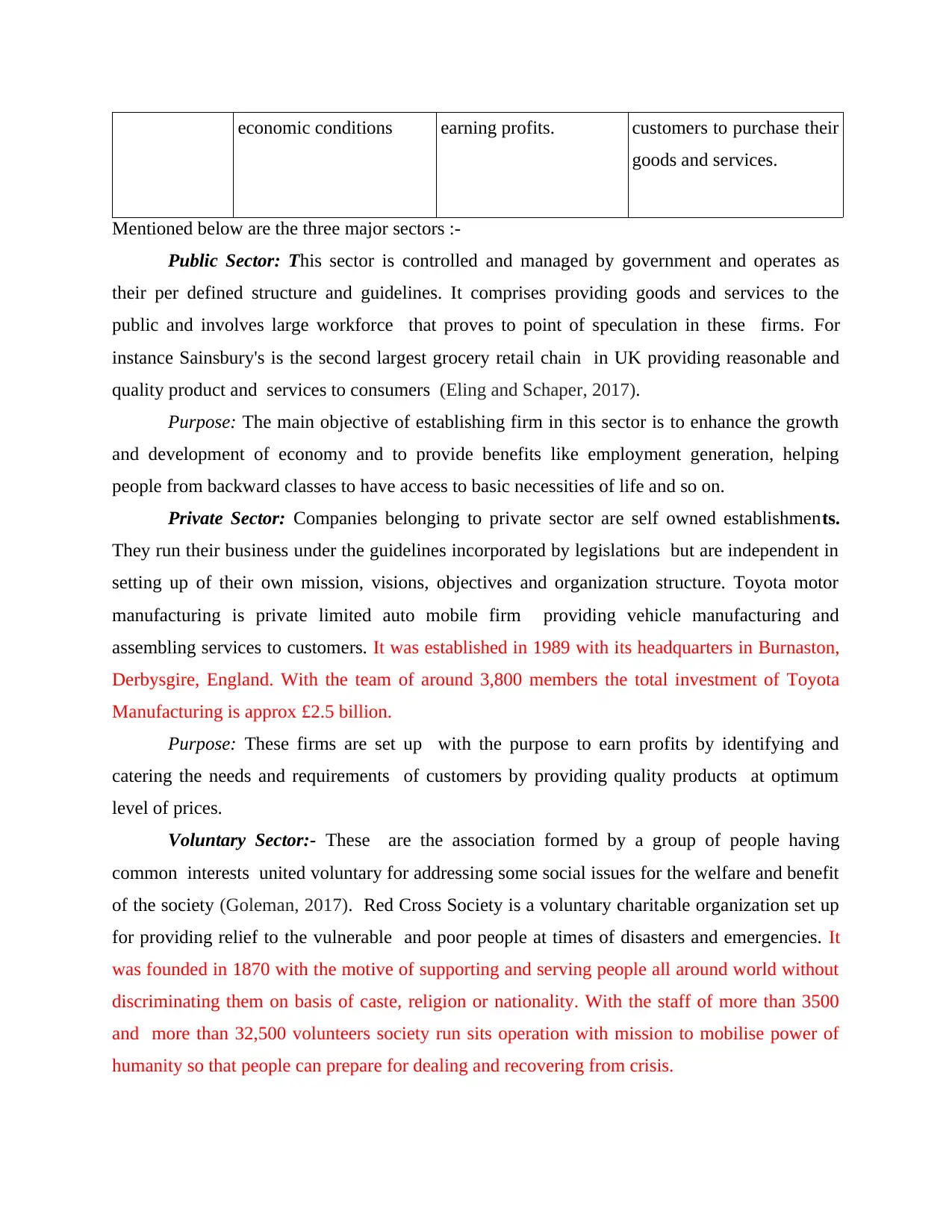
economic conditions earning profits. customers to purchase their
goods and services.
Mentioned below are the three major sectors :-
Public Sector: This sector is controlled and managed by government and operates as
their per defined structure and guidelines. It comprises providing goods and services to the
public and involves large workforce that proves to point of speculation in these firms. For
instance Sainsbury's is the second largest grocery retail chain in UK providing reasonable and
quality product and services to consumers (Eling and Schaper, 2017).
Purpose: The main objective of establishing firm in this sector is to enhance the growth
and development of economy and to provide benefits like employment generation, helping
people from backward classes to have access to basic necessities of life and so on.
Private Sector: Companies belonging to private sector are self owned establishments.
They run their business under the guidelines incorporated by legislations but are independent in
setting up of their own mission, visions, objectives and organization structure. Toyota motor
manufacturing is private limited auto mobile firm providing vehicle manufacturing and
assembling services to customers. It was established in 1989 with its headquarters in Burnaston,
Derbysgire, England. With the team of around 3,800 members the total investment of Toyota
Manufacturing is approx £2.5 billion.
Purpose: These firms are set up with the purpose to earn profits by identifying and
catering the needs and requirements of customers by providing quality products at optimum
level of prices.
Voluntary Sector:- These are the association formed by a group of people having
common interests united voluntary for addressing some social issues for the welfare and benefit
of the society (Goleman, 2017). Red Cross Society is a voluntary charitable organization set up
for providing relief to the vulnerable and poor people at times of disasters and emergencies. It
was founded in 1870 with the motive of supporting and serving people all around world without
discriminating them on basis of caste, religion or nationality. With the staff of more than 3500
and more than 32,500 volunteers society run sits operation with mission to mobilise power of
humanity so that people can prepare for dealing and recovering from crisis.
goods and services.
Mentioned below are the three major sectors :-
Public Sector: This sector is controlled and managed by government and operates as
their per defined structure and guidelines. It comprises providing goods and services to the
public and involves large workforce that proves to point of speculation in these firms. For
instance Sainsbury's is the second largest grocery retail chain in UK providing reasonable and
quality product and services to consumers (Eling and Schaper, 2017).
Purpose: The main objective of establishing firm in this sector is to enhance the growth
and development of economy and to provide benefits like employment generation, helping
people from backward classes to have access to basic necessities of life and so on.
Private Sector: Companies belonging to private sector are self owned establishments.
They run their business under the guidelines incorporated by legislations but are independent in
setting up of their own mission, visions, objectives and organization structure. Toyota motor
manufacturing is private limited auto mobile firm providing vehicle manufacturing and
assembling services to customers. It was established in 1989 with its headquarters in Burnaston,
Derbysgire, England. With the team of around 3,800 members the total investment of Toyota
Manufacturing is approx £2.5 billion.
Purpose: These firms are set up with the purpose to earn profits by identifying and
catering the needs and requirements of customers by providing quality products at optimum
level of prices.
Voluntary Sector:- These are the association formed by a group of people having
common interests united voluntary for addressing some social issues for the welfare and benefit
of the society (Goleman, 2017). Red Cross Society is a voluntary charitable organization set up
for providing relief to the vulnerable and poor people at times of disasters and emergencies. It
was founded in 1870 with the motive of supporting and serving people all around world without
discriminating them on basis of caste, religion or nationality. With the staff of more than 3500
and more than 32,500 volunteers society run sits operation with mission to mobilise power of
humanity so that people can prepare for dealing and recovering from crisis.
Paraphrase This Document
Need a fresh take? Get an instant paraphrase of this document with our AI Paraphraser
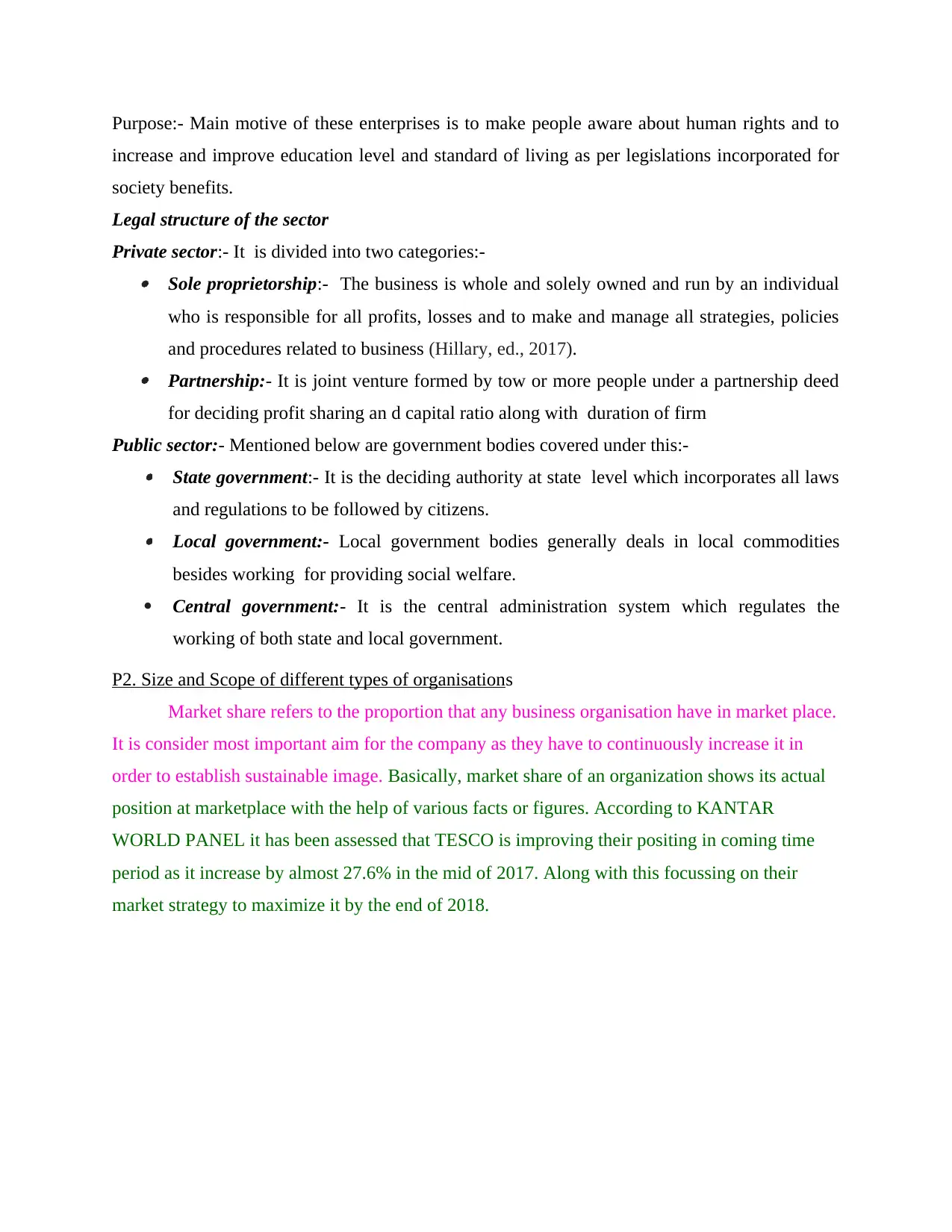
Purpose:- Main motive of these enterprises is to make people aware about human rights and to
increase and improve education level and standard of living as per legislations incorporated for
society benefits.
Legal structure of the sector
Private sector:- It is divided into two categories:- Sole proprietorship:- The business is whole and solely owned and run by an individual
who is responsible for all profits, losses and to make and manage all strategies, policies
and procedures related to business (Hillary, ed., 2017). Partnership:- It is joint venture formed by tow or more people under a partnership deed
for deciding profit sharing an d capital ratio along with duration of firm
Public sector:- Mentioned below are government bodies covered under this:- State government:- It is the deciding authority at state level which incorporates all laws
and regulations to be followed by citizens. Local government:- Local government bodies generally deals in local commodities
besides working for providing social welfare.
Central government:- It is the central administration system which regulates the
working of both state and local government.
P2. Size and Scope of different types of organisations
Market share refers to the proportion that any business organisation have in market place.
It is consider most important aim for the company as they have to continuously increase it in
order to establish sustainable image. Basically, market share of an organization shows its actual
position at marketplace with the help of various facts or figures. According to KANTAR
WORLD PANEL it has been assessed that TESCO is improving their positing in coming time
period as it increase by almost 27.6% in the mid of 2017. Along with this focussing on their
market strategy to maximize it by the end of 2018.
increase and improve education level and standard of living as per legislations incorporated for
society benefits.
Legal structure of the sector
Private sector:- It is divided into two categories:- Sole proprietorship:- The business is whole and solely owned and run by an individual
who is responsible for all profits, losses and to make and manage all strategies, policies
and procedures related to business (Hillary, ed., 2017). Partnership:- It is joint venture formed by tow or more people under a partnership deed
for deciding profit sharing an d capital ratio along with duration of firm
Public sector:- Mentioned below are government bodies covered under this:- State government:- It is the deciding authority at state level which incorporates all laws
and regulations to be followed by citizens. Local government:- Local government bodies generally deals in local commodities
besides working for providing social welfare.
Central government:- It is the central administration system which regulates the
working of both state and local government.
P2. Size and Scope of different types of organisations
Market share refers to the proportion that any business organisation have in market place.
It is consider most important aim for the company as they have to continuously increase it in
order to establish sustainable image. Basically, market share of an organization shows its actual
position at marketplace with the help of various facts or figures. According to KANTAR
WORLD PANEL it has been assessed that TESCO is improving their positing in coming time
period as it increase by almost 27.6% in the mid of 2017. Along with this focussing on their
market strategy to maximize it by the end of 2018.
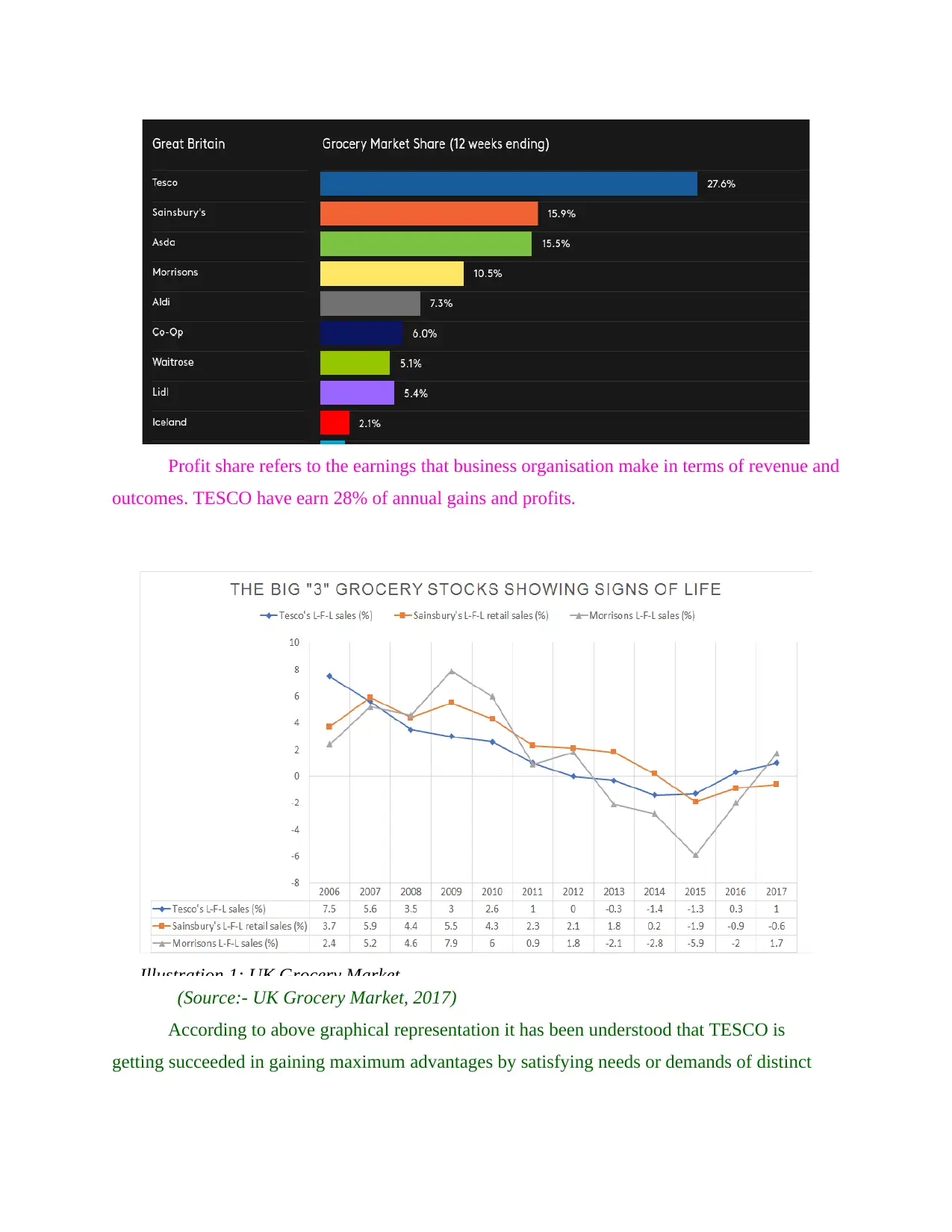
Profit share refers to the earnings that business organisation make in terms of revenue and
outcomes. TESCO have earn 28% of annual gains and profits.
(Source:- UK Grocery Market, 2017)
According to above graphical representation it has been understood that TESCO is
getting succeeded in gaining maximum advantages by satisfying needs or demands of distinct
Illustration 1: UK Grocery Market
outcomes. TESCO have earn 28% of annual gains and profits.
(Source:- UK Grocery Market, 2017)
According to above graphical representation it has been understood that TESCO is
getting succeeded in gaining maximum advantages by satisfying needs or demands of distinct
Illustration 1: UK Grocery Market
⊘ This is a preview!⊘
Do you want full access?
Subscribe today to unlock all pages.

Trusted by 1+ million students worldwide
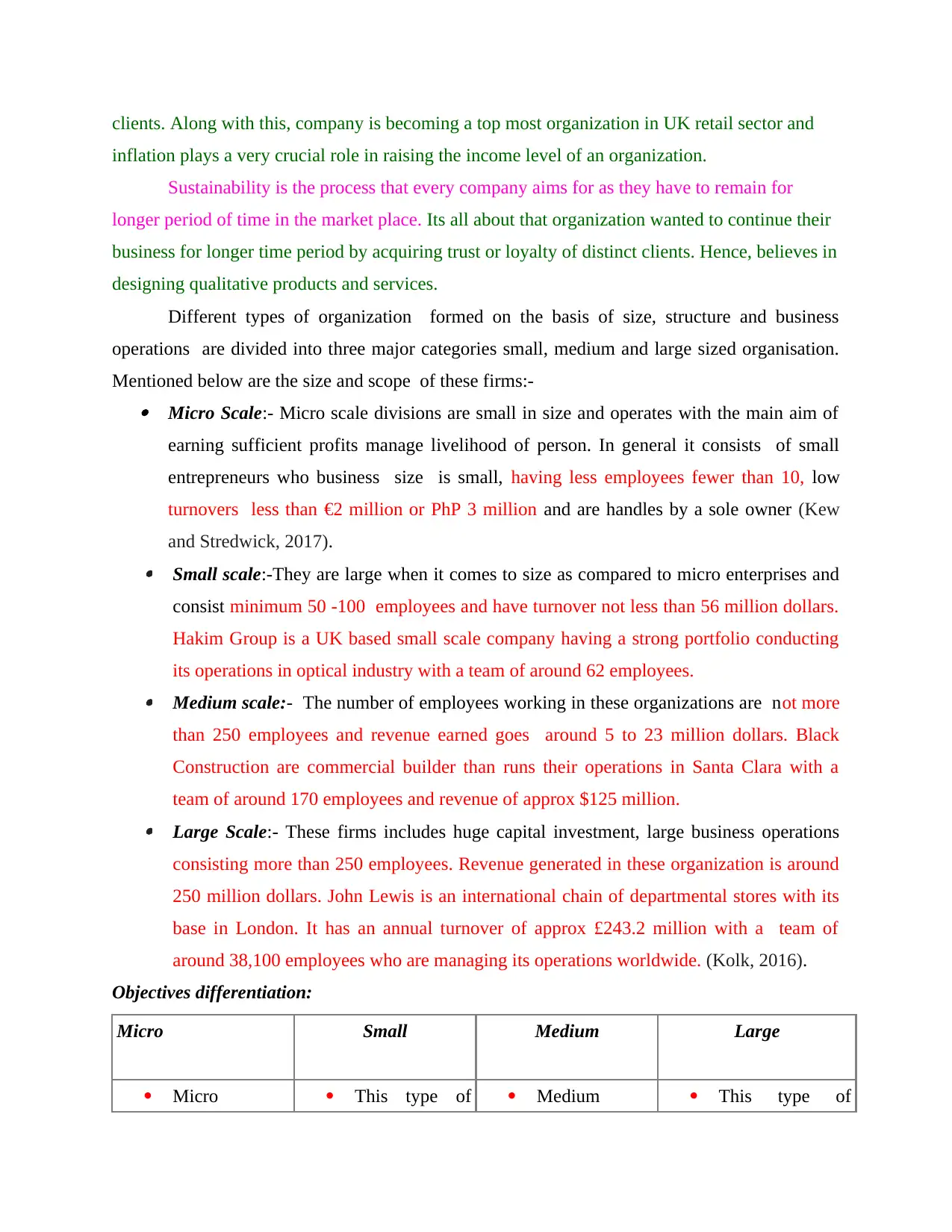
clients. Along with this, company is becoming a top most organization in UK retail sector and
inflation plays a very crucial role in raising the income level of an organization.
Sustainability is the process that every company aims for as they have to remain for
longer period of time in the market place. Its all about that organization wanted to continue their
business for longer time period by acquiring trust or loyalty of distinct clients. Hence, believes in
designing qualitative products and services.
Different types of organization formed on the basis of size, structure and business
operations are divided into three major categories small, medium and large sized organisation.
Mentioned below are the size and scope of these firms:- Micro Scale:- Micro scale divisions are small in size and operates with the main aim of
earning sufficient profits manage livelihood of person. In general it consists of small
entrepreneurs who business size is small, having less employees fewer than 10, low
turnovers less than €2 million or PhP 3 million and are handles by a sole owner (Kew
and Stredwick, 2017). Small scale:-They are large when it comes to size as compared to micro enterprises and
consist minimum 50 -100 employees and have turnover not less than 56 million dollars.
Hakim Group is a UK based small scale company having a strong portfolio conducting
its operations in optical industry with a team of around 62 employees. Medium scale:- The number of employees working in these organizations are not more
than 250 employees and revenue earned goes around 5 to 23 million dollars. Black
Construction are commercial builder than runs their operations in Santa Clara with a
team of around 170 employees and revenue of approx $125 million. Large Scale:- These firms includes huge capital investment, large business operations
consisting more than 250 employees. Revenue generated in these organization is around
250 million dollars. John Lewis is an international chain of departmental stores with its
base in London. It has an annual turnover of approx £243.2 million with a team of
around 38,100 employees who are managing its operations worldwide. (Kolk, 2016).
Objectives differentiation:
Micro Small Medium Large
Micro This type of Medium This type of
inflation plays a very crucial role in raising the income level of an organization.
Sustainability is the process that every company aims for as they have to remain for
longer period of time in the market place. Its all about that organization wanted to continue their
business for longer time period by acquiring trust or loyalty of distinct clients. Hence, believes in
designing qualitative products and services.
Different types of organization formed on the basis of size, structure and business
operations are divided into three major categories small, medium and large sized organisation.
Mentioned below are the size and scope of these firms:- Micro Scale:- Micro scale divisions are small in size and operates with the main aim of
earning sufficient profits manage livelihood of person. In general it consists of small
entrepreneurs who business size is small, having less employees fewer than 10, low
turnovers less than €2 million or PhP 3 million and are handles by a sole owner (Kew
and Stredwick, 2017). Small scale:-They are large when it comes to size as compared to micro enterprises and
consist minimum 50 -100 employees and have turnover not less than 56 million dollars.
Hakim Group is a UK based small scale company having a strong portfolio conducting
its operations in optical industry with a team of around 62 employees. Medium scale:- The number of employees working in these organizations are not more
than 250 employees and revenue earned goes around 5 to 23 million dollars. Black
Construction are commercial builder than runs their operations in Santa Clara with a
team of around 170 employees and revenue of approx $125 million. Large Scale:- These firms includes huge capital investment, large business operations
consisting more than 250 employees. Revenue generated in these organization is around
250 million dollars. John Lewis is an international chain of departmental stores with its
base in London. It has an annual turnover of approx £243.2 million with a team of
around 38,100 employees who are managing its operations worldwide. (Kolk, 2016).
Objectives differentiation:
Micro Small Medium Large
Micro This type of Medium This type of
Paraphrase This Document
Need a fresh take? Get an instant paraphrase of this document with our AI Paraphraser
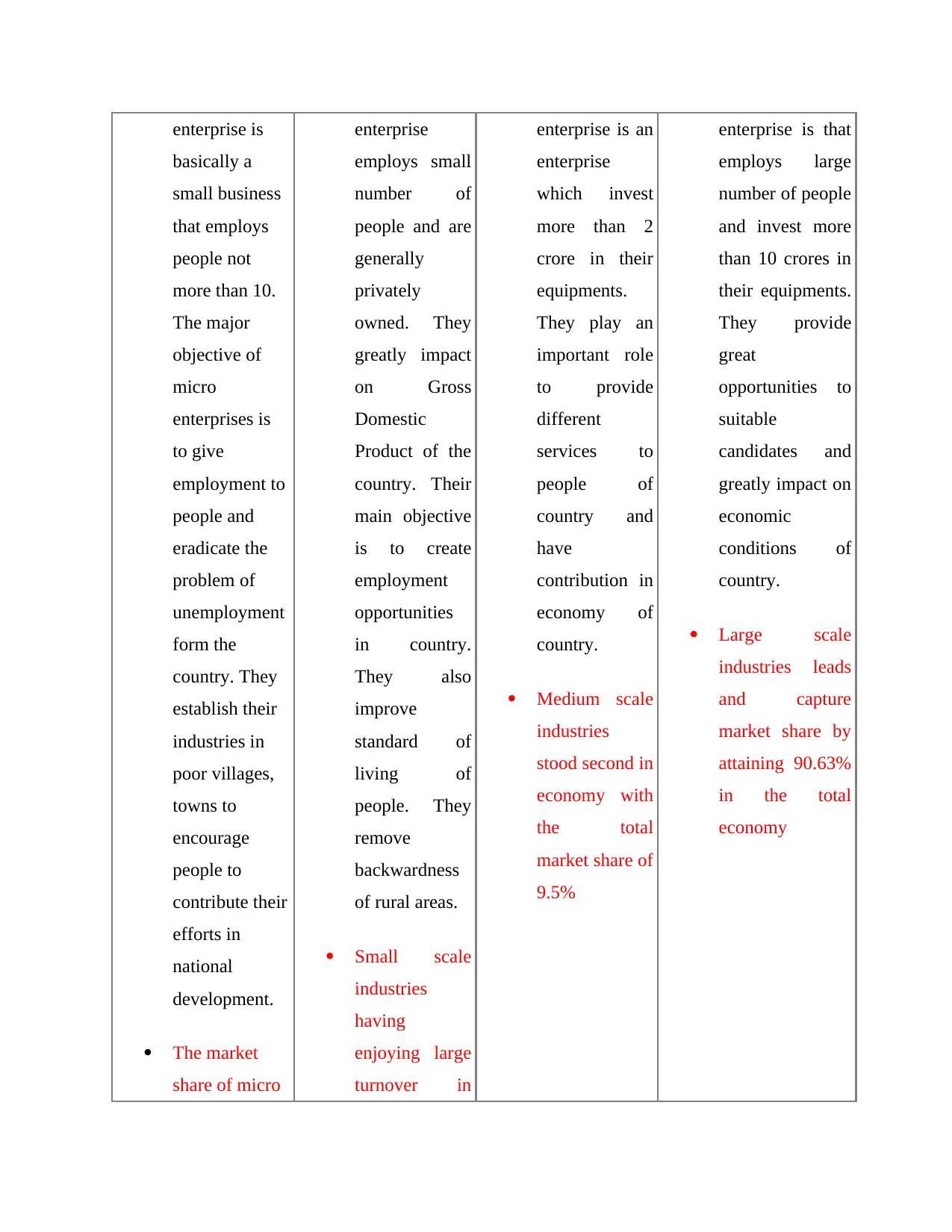
enterprise is
basically a
small business
that employs
people not
more than 10.
The major
objective of
micro
enterprises is
to give
employment to
people and
eradicate the
problem of
unemployment
form the
country. They
establish their
industries in
poor villages,
towns to
encourage
people to
contribute their
efforts in
national
development.
The market
share of micro
enterprise
employs small
number of
people and are
generally
privately
owned. They
greatly impact
on Gross
Domestic
Product of the
country. Their
main objective
is to create
employment
opportunities
in country.
They also
improve
standard of
living of
people. They
remove
backwardness
of rural areas.
Small scale
industries
having
enjoying large
turnover in
enterprise is an
enterprise
which invest
more than 2
crore in their
equipments.
They play an
important role
to provide
different
services to
people of
country and
have
contribution in
economy of
country.
Medium scale
industries
stood second in
economy with
the total
market share of
9.5%
enterprise is that
employs large
number of people
and invest more
than 10 crores in
their equipments.
They provide
great
opportunities to
suitable
candidates and
greatly impact on
economic
conditions of
country.
Large scale
industries leads
and capture
market share by
attaining 90.63%
in the total
economy
basically a
small business
that employs
people not
more than 10.
The major
objective of
micro
enterprises is
to give
employment to
people and
eradicate the
problem of
unemployment
form the
country. They
establish their
industries in
poor villages,
towns to
encourage
people to
contribute their
efforts in
national
development.
The market
share of micro
enterprise
employs small
number of
people and are
generally
privately
owned. They
greatly impact
on Gross
Domestic
Product of the
country. Their
main objective
is to create
employment
opportunities
in country.
They also
improve
standard of
living of
people. They
remove
backwardness
of rural areas.
Small scale
industries
having
enjoying large
turnover in
enterprise is an
enterprise
which invest
more than 2
crore in their
equipments.
They play an
important role
to provide
different
services to
people of
country and
have
contribution in
economy of
country.
Medium scale
industries
stood second in
economy with
the total
market share of
9.5%
enterprise is that
employs large
number of people
and invest more
than 10 crores in
their equipments.
They provide
great
opportunities to
suitable
candidates and
greatly impact on
economic
conditions of
country.
Large scale
industries leads
and capture
market share by
attaining 90.63%
in the total
economy
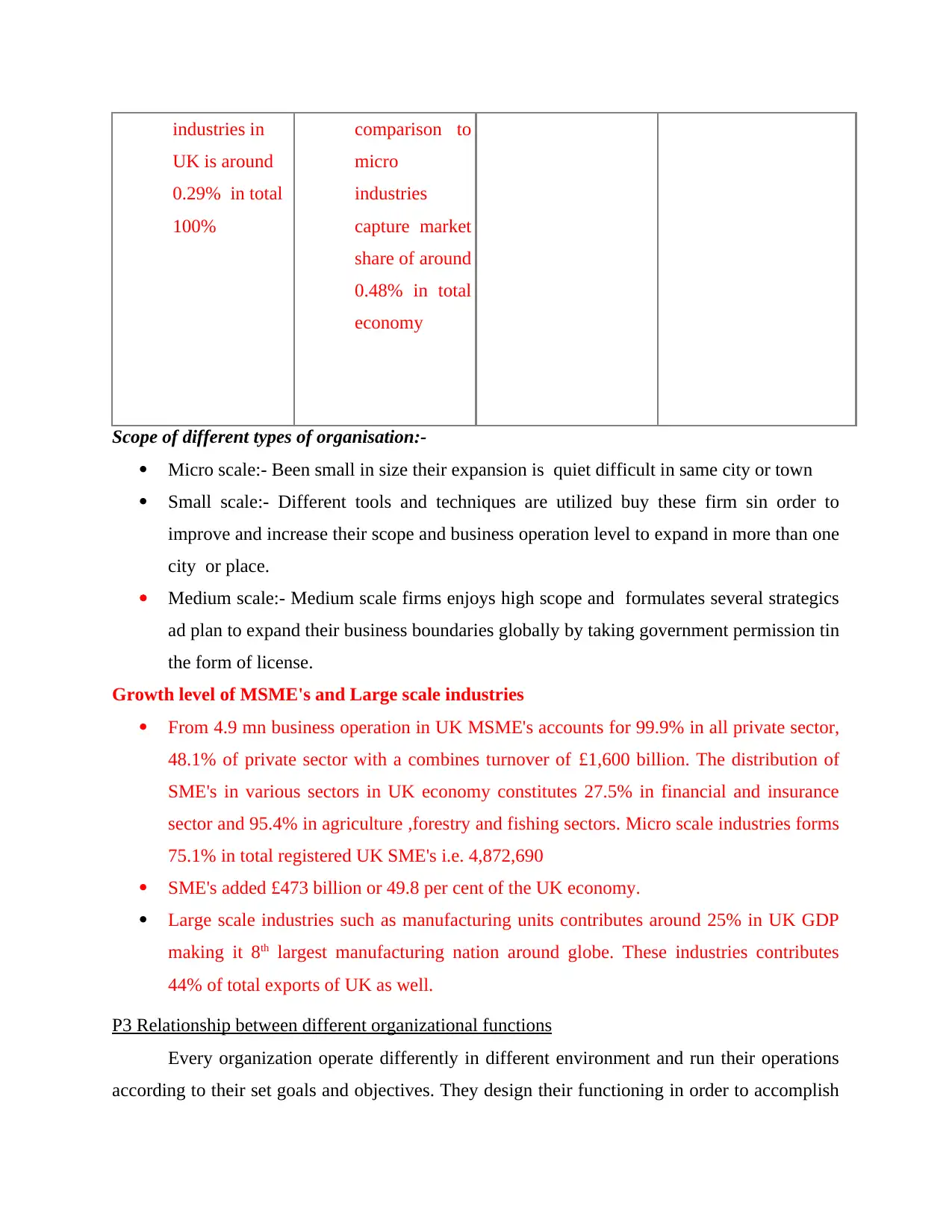
industries in
UK is around
0.29% in total
100%
comparison to
micro
industries
capture market
share of around
0.48% in total
economy
Scope of different types of organisation:-
Micro scale:- Been small in size their expansion is quiet difficult in same city or town
Small scale:- Different tools and techniques are utilized buy these firm sin order to
improve and increase their scope and business operation level to expand in more than one
city or place.
Medium scale:- Medium scale firms enjoys high scope and formulates several strategics
ad plan to expand their business boundaries globally by taking government permission tin
the form of license.
Growth level of MSME's and Large scale industries
From 4.9 mn business operation in UK MSME's accounts for 99.9% in all private sector,
48.1% of private sector with a combines turnover of £1,600 billion. The distribution of
SME's in various sectors in UK economy constitutes 27.5% in financial and insurance
sector and 95.4% in agriculture ,forestry and fishing sectors. Micro scale industries forms
75.1% in total registered UK SME's i.e. 4,872,690
SME's added £473 billion or 49.8 per cent of the UK economy.
Large scale industries such as manufacturing units contributes around 25% in UK GDP
making it 8th largest manufacturing nation around globe. These industries contributes
44% of total exports of UK as well.
P3 Relationship between different organizational functions
Every organization operate differently in different environment and run their operations
according to their set goals and objectives. They design their functioning in order to accomplish
UK is around
0.29% in total
100%
comparison to
micro
industries
capture market
share of around
0.48% in total
economy
Scope of different types of organisation:-
Micro scale:- Been small in size their expansion is quiet difficult in same city or town
Small scale:- Different tools and techniques are utilized buy these firm sin order to
improve and increase their scope and business operation level to expand in more than one
city or place.
Medium scale:- Medium scale firms enjoys high scope and formulates several strategics
ad plan to expand their business boundaries globally by taking government permission tin
the form of license.
Growth level of MSME's and Large scale industries
From 4.9 mn business operation in UK MSME's accounts for 99.9% in all private sector,
48.1% of private sector with a combines turnover of £1,600 billion. The distribution of
SME's in various sectors in UK economy constitutes 27.5% in financial and insurance
sector and 95.4% in agriculture ,forestry and fishing sectors. Micro scale industries forms
75.1% in total registered UK SME's i.e. 4,872,690
SME's added £473 billion or 49.8 per cent of the UK economy.
Large scale industries such as manufacturing units contributes around 25% in UK GDP
making it 8th largest manufacturing nation around globe. These industries contributes
44% of total exports of UK as well.
P3 Relationship between different organizational functions
Every organization operate differently in different environment and run their operations
according to their set goals and objectives. They design their functioning in order to accomplish
⊘ This is a preview!⊘
Do you want full access?
Subscribe today to unlock all pages.

Trusted by 1+ million students worldwide
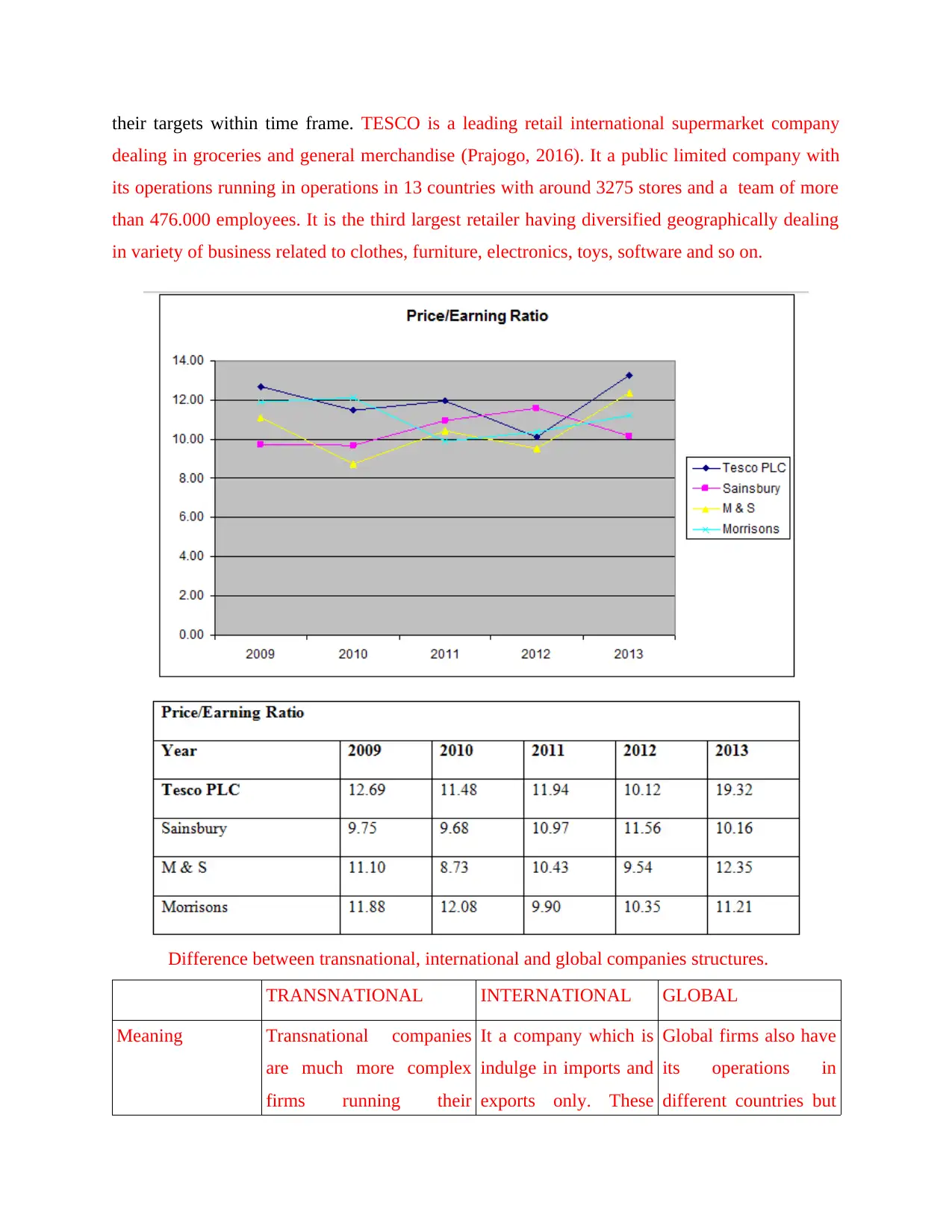
their targets within time frame. TESCO is a leading retail international supermarket company
dealing in groceries and general merchandise (Prajogo, 2016). It a public limited company with
its operations running in operations in 13 countries with around 3275 stores and a team of more
than 476.000 employees. It is the third largest retailer having diversified geographically dealing
in variety of business related to clothes, furniture, electronics, toys, software and so on.
Difference between transnational, international and global companies structures.
TRANSNATIONAL INTERNATIONAL GLOBAL
Meaning Transnational companies
are much more complex
firms running their
It a company which is
indulge in imports and
exports only. These
Global firms also have
its operations in
different countries but
dealing in groceries and general merchandise (Prajogo, 2016). It a public limited company with
its operations running in operations in 13 countries with around 3275 stores and a team of more
than 476.000 employees. It is the third largest retailer having diversified geographically dealing
in variety of business related to clothes, furniture, electronics, toys, software and so on.
Difference between transnational, international and global companies structures.
TRANSNATIONAL INTERNATIONAL GLOBAL
Meaning Transnational companies
are much more complex
firms running their
It a company which is
indulge in imports and
exports only. These
Global firms also have
its operations in
different countries but
Paraphrase This Document
Need a fresh take? Get an instant paraphrase of this document with our AI Paraphraser
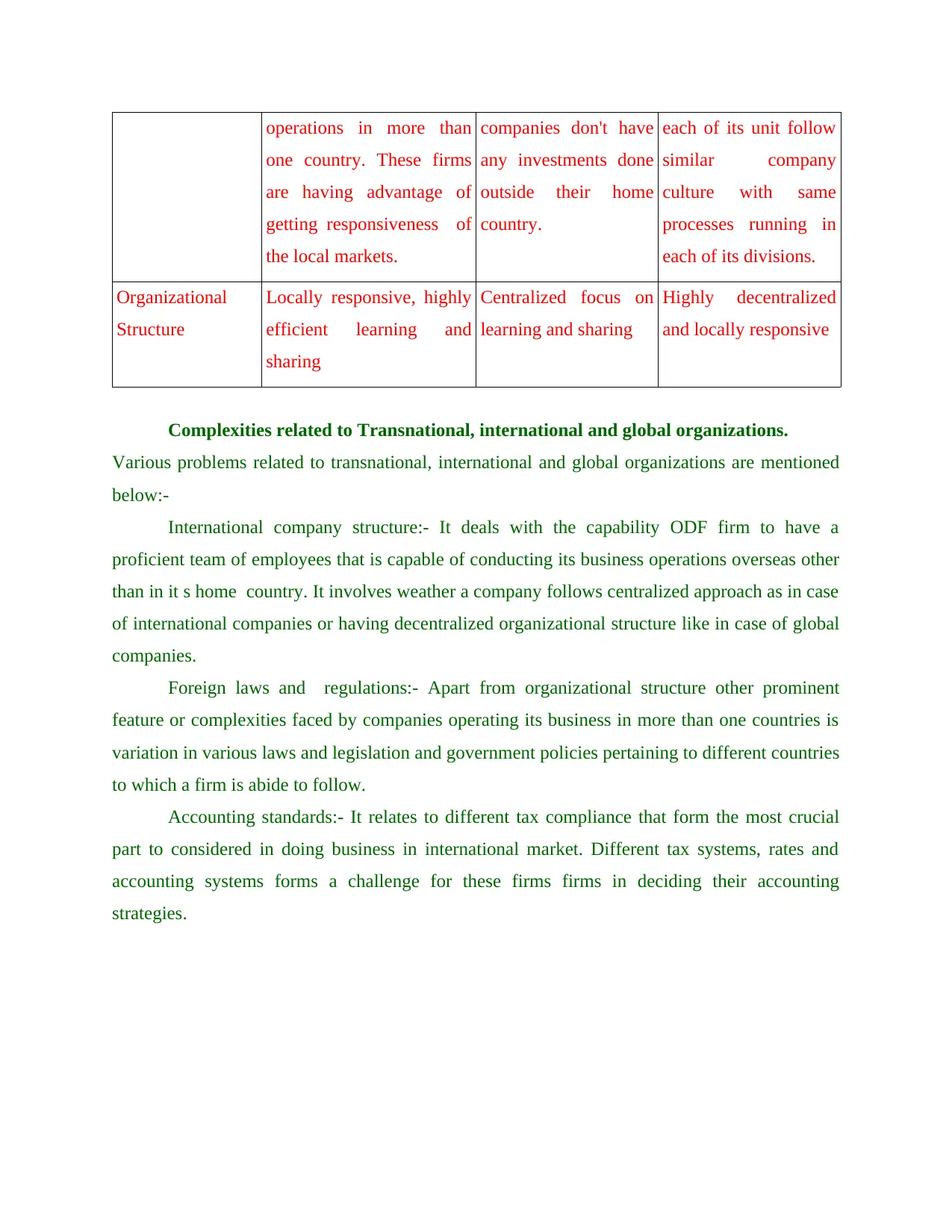
operations in more than
one country. These firms
are having advantage of
getting responsiveness of
the local markets.
companies don't have
any investments done
outside their home
country.
each of its unit follow
similar company
culture with same
processes running in
each of its divisions.
Organizational
Structure
Locally responsive, highly
efficient learning and
sharing
Centralized focus on
learning and sharing
Highly decentralized
and locally responsive
Complexities related to Transnational, international and global organizations.
Various problems related to transnational, international and global organizations are mentioned
below:-
International company structure:- It deals with the capability ODF firm to have a
proficient team of employees that is capable of conducting its business operations overseas other
than in it s home country. It involves weather a company follows centralized approach as in case
of international companies or having decentralized organizational structure like in case of global
companies.
Foreign laws and regulations:- Apart from organizational structure other prominent
feature or complexities faced by companies operating its business in more than one countries is
variation in various laws and legislation and government policies pertaining to different countries
to which a firm is abide to follow.
Accounting standards:- It relates to different tax compliance that form the most crucial
part to considered in doing business in international market. Different tax systems, rates and
accounting systems forms a challenge for these firms firms in deciding their accounting
strategies.
one country. These firms
are having advantage of
getting responsiveness of
the local markets.
companies don't have
any investments done
outside their home
country.
each of its unit follow
similar company
culture with same
processes running in
each of its divisions.
Organizational
Structure
Locally responsive, highly
efficient learning and
sharing
Centralized focus on
learning and sharing
Highly decentralized
and locally responsive
Complexities related to Transnational, international and global organizations.
Various problems related to transnational, international and global organizations are mentioned
below:-
International company structure:- It deals with the capability ODF firm to have a
proficient team of employees that is capable of conducting its business operations overseas other
than in it s home country. It involves weather a company follows centralized approach as in case
of international companies or having decentralized organizational structure like in case of global
companies.
Foreign laws and regulations:- Apart from organizational structure other prominent
feature or complexities faced by companies operating its business in more than one countries is
variation in various laws and legislation and government policies pertaining to different countries
to which a firm is abide to follow.
Accounting standards:- It relates to different tax compliance that form the most crucial
part to considered in doing business in international market. Different tax systems, rates and
accounting systems forms a challenge for these firms firms in deciding their accounting
strategies.
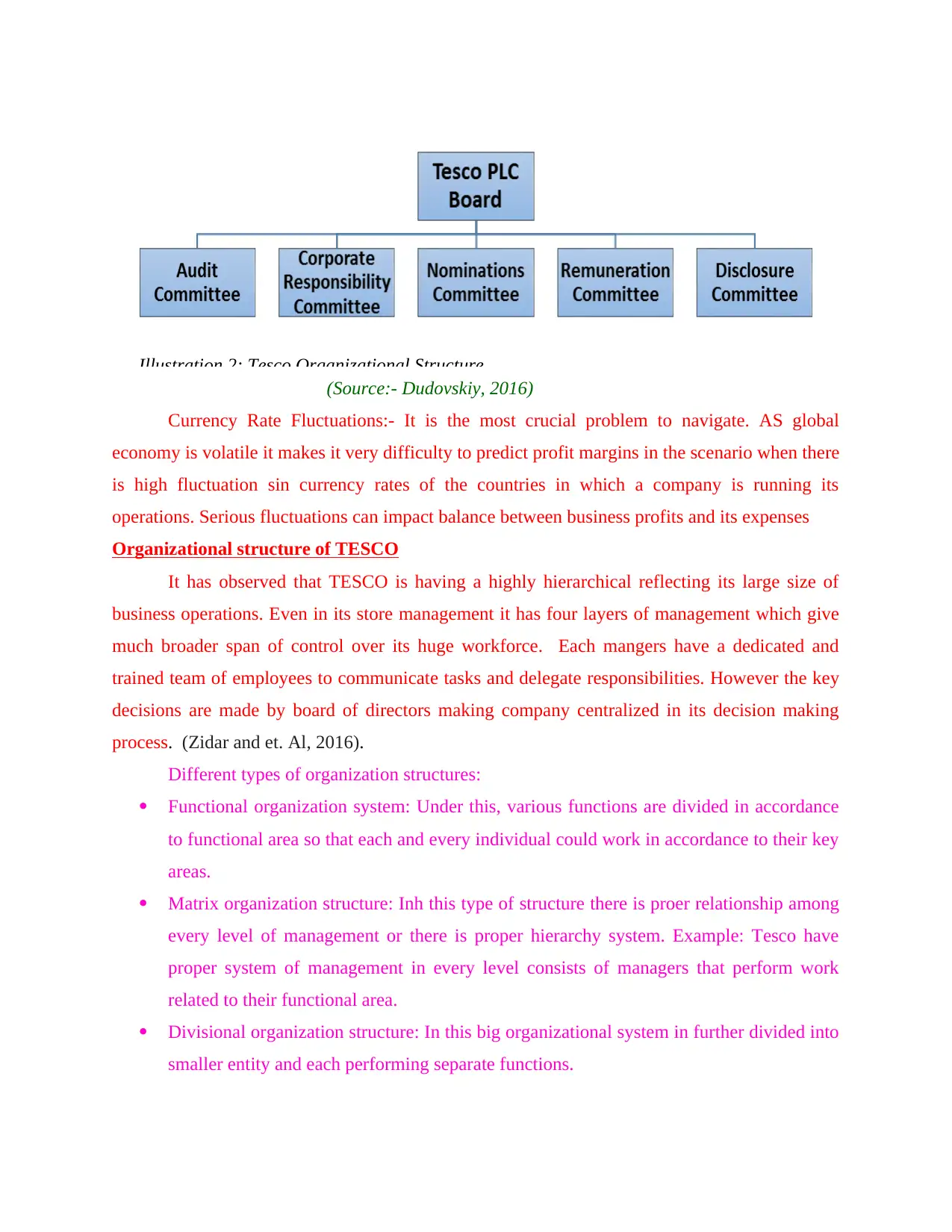
(Source:- Dudovskiy, 2016)
Currency Rate Fluctuations:- It is the most crucial problem to navigate. AS global
economy is volatile it makes it very difficulty to predict profit margins in the scenario when there
is high fluctuation sin currency rates of the countries in which a company is running its
operations. Serious fluctuations can impact balance between business profits and its expenses
Organizational structure of TESCO
It has observed that TESCO is having a highly hierarchical reflecting its large size of
business operations. Even in its store management it has four layers of management which give
much broader span of control over its huge workforce. Each mangers have a dedicated and
trained team of employees to communicate tasks and delegate responsibilities. However the key
decisions are made by board of directors making company centralized in its decision making
process. (Zidar and et. Al, 2016).
Different types of organization structures:
Functional organization system: Under this, various functions are divided in accordance
to functional area so that each and every individual could work in accordance to their key
areas.
Matrix organization structure: Inh this type of structure there is proer relationship among
every level of management or there is proper hierarchy system. Example: Tesco have
proper system of management in every level consists of managers that perform work
related to their functional area.
Divisional organization structure: In this big organizational system in further divided into
smaller entity and each performing separate functions.
Illustration 2: Tesco Organizational Structure
Currency Rate Fluctuations:- It is the most crucial problem to navigate. AS global
economy is volatile it makes it very difficulty to predict profit margins in the scenario when there
is high fluctuation sin currency rates of the countries in which a company is running its
operations. Serious fluctuations can impact balance between business profits and its expenses
Organizational structure of TESCO
It has observed that TESCO is having a highly hierarchical reflecting its large size of
business operations. Even in its store management it has four layers of management which give
much broader span of control over its huge workforce. Each mangers have a dedicated and
trained team of employees to communicate tasks and delegate responsibilities. However the key
decisions are made by board of directors making company centralized in its decision making
process. (Zidar and et. Al, 2016).
Different types of organization structures:
Functional organization system: Under this, various functions are divided in accordance
to functional area so that each and every individual could work in accordance to their key
areas.
Matrix organization structure: Inh this type of structure there is proer relationship among
every level of management or there is proper hierarchy system. Example: Tesco have
proper system of management in every level consists of managers that perform work
related to their functional area.
Divisional organization structure: In this big organizational system in further divided into
smaller entity and each performing separate functions.
Illustration 2: Tesco Organizational Structure
⊘ This is a preview!⊘
Do you want full access?
Subscribe today to unlock all pages.

Trusted by 1+ million students worldwide
1 out of 22
Related Documents
Your All-in-One AI-Powered Toolkit for Academic Success.
+13062052269
info@desklib.com
Available 24*7 on WhatsApp / Email
![[object Object]](/_next/static/media/star-bottom.7253800d.svg)
Unlock your academic potential
Copyright © 2020–2025 A2Z Services. All Rights Reserved. Developed and managed by ZUCOL.





